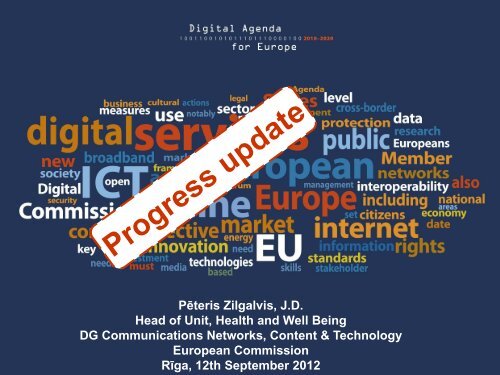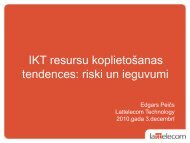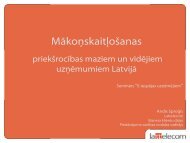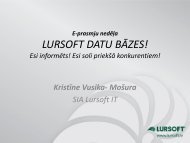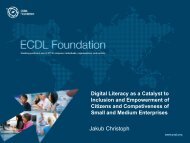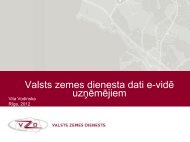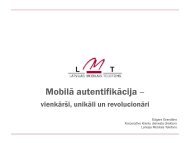PÄteris Zilgalvis, JD Head of Unit, Health and Well Being DG ... - LIKTA
PÄteris Zilgalvis, JD Head of Unit, Health and Well Being DG ... - LIKTA
PÄteris Zilgalvis, JD Head of Unit, Health and Well Being DG ... - LIKTA
You also want an ePaper? Increase the reach of your titles
YUMPU automatically turns print PDFs into web optimized ePapers that Google loves.
Pēteris <strong>Zilgalvis</strong>, J.D.<strong>Head</strong> <strong>of</strong> <strong>Unit</strong>, <strong>Health</strong> <strong>and</strong> <strong>Well</strong> <strong>Being</strong><strong>DG</strong> Communications Networks, Content & TechnologyEuropean CommissionRīga, 12th September 2012
Background• Digital Agenda for Europe - key str<strong>and</strong> <strong>of</strong> the Commission'sEU2020 strategy• Aim: to establish sustained digital growth in Europe via 101actions• Overall progress good:• 38 actions completed• 49 on track• 14 actions behind schedule, but delivery dates in 2012• Forthcoming Mid-term review will provide analysis
Progress• Key actions: 14 completed; 5 on track; 2 behind schedule• Rates <strong>of</strong> penetration <strong>of</strong> high-speed broadb<strong>and</strong> networks inEurope are increasing;• High-speed Broadb<strong>and</strong> coverage: 29% 2010; 50% 2011• 68% citizens go online weekly• 58% <strong>of</strong> net users purchased online
Source: European Commission - Digital Agenda Scoreboard 2012Progress
Basic <strong>and</strong> high-speed broadb<strong>and</strong> penetration45,0%40,0%35,0%30,0%25,0%20,0%15,0%10,0%5,0%0,0%RO BG SK PL LV PT EL HU IT LT CZ IE SI ES CY AT EE EU FI MT UK LU SE BE DE FR DK NLBasicHigh-speedSource: Commission services based on COCOM Total number <strong>of</strong> subscription by households <strong>and</strong> enterprises divided by population.
LatviaRegular internet users68%66%Source: http://ec.europa.eu/information_society/digital-agenda/scoreboard/countries/lv/internet_services/index_en.htm
ROBGITLTGRPTLVEECYHUESPLCZSISKEU27IEBEATMTFRFIDELUNLDKSEUK80%eCommerce: online purchases70%60%50%40%30%20%10%0%bought online cross-borderbought onlineSource: Eurostat, Community survey on ICT usage in households <strong>and</strong> by individuals, 2011: percentage <strong>of</strong> individuals between 16 <strong>and</strong> 74 who orderedgoods or services for private use during the last year, <strong>and</strong> who ordered from sellers in other EU countries; horizontal lines represent targets
Basic computer <strong>and</strong> Internet skills• Half <strong>of</strong> regular <strong>and</strong> frequent internet users have medium skills; over a third have low skills• Member States with higher rates <strong>of</strong> computer <strong>and</strong> internet users tend to have higher rates<strong>of</strong> medium <strong>and</strong> high-skilled people• EU27: 8% <strong>of</strong> internet users in previous 3 months
LatviaSkills <strong>of</strong> Internet users (2011)29%Source: http://ec.europa.eu/information_society/digital-agenda/scoreboard/countries/lv/internet_services/index_en.htm• 73% <strong>of</strong> Latvians have internet skills. 29% <strong>of</strong> them have high computer skills, a considerable12 p.p. boost from 2009, that brings the country close <strong>and</strong> above the EU average <strong>of</strong> 27%.• Latvia is among the leading countries !
7000Public ICT R&D expenditure60005000400030002000100002004 2005 2006 2007 2008 2009 2010Actual ICT R&DTrajectory to reach targetSource: IPTS. Values for EU27 in € millions.Note: the baseline estimate for 2007 has been revised, due to a new methodology; new data cover two years (2009 <strong>and</strong> 2010)
Latvia & the FP7 ICT Programme• Participation has decreased from ~0.08% in FP5 <strong>and</strong> FP6 to ~0.04% so far in FP7• Participation is strongly concentrated in Language technologies, ICT forgovernance <strong>and</strong> Future <strong>and</strong> Emerging Technologies (FET)• SME participation in FP7 is strong (~33% <strong>of</strong> funding) but exclusively concentratedin one organisation. Large enterprises are totally absent• The important increase <strong>of</strong> budget allocated to FET for the final years <strong>of</strong> FP7represents an opportunity• The risk <strong>of</strong> missing strategic opportunities in the future could be minimized byensuring a balanced participation across a broader set <strong>of</strong> research themes• The introduction <strong>of</strong> an "Open fast <strong>and</strong> light" funding scheme in H2020 is expectedto help reducing the barrier to entry for Latvian entities
Going Local• Commission visits to Member States to engage with stakeholders:• Report on progress <strong>of</strong> the Digital Agenda• Identify challenges for the future• Stimulate actions <strong>and</strong> commitments• Exercise conducted in 2010 <strong>and</strong> 2011; 2012 programme expected totarget issues in key Member States
Digital Agenda Assembly• Annual assembly envisaged in DAE – to assess progress to date <strong>and</strong>Identify challenges ahead for implementation <strong>of</strong> the Digital Agenda• Mobilise stakeholders' actions to ensure further progress <strong>and</strong> addresschallenges• DAA 2011 & DAA 2012 (Brussels); DAA2013 (Dublin)• DAA 2012• 8 workshops: Converged Media; High-speed connections; e-Commerce; Social Media; Data; Cloud; Security; Innovation <strong>and</strong>entrepreneurs• 1 plenary: panel discussions – growth & jobs; innovation; socialactivism• 1,200+ attendees
Online stakeholder engagement platform• Online space for discussion <strong>and</strong> feedback to deed into DAA12 <strong>and</strong> MTR• 1,400 members submitted 2,000+ contributions in 2 months• Most 'liked' contributors were invited to attend the DAA
DAE Mid-term review• Consider DAE progress to date• Identify priority DAE areas that require additional impetus• Review includes input from:• Digital scoreboard• Digital Agenda Assembly (June 2012)• Stakeholder engagement (Going Local, online platform)
DAE Mid-term review: priority areas• Very Fast Internet• Cloud Computing• Safety & Security• Entrepreneurship <strong>and</strong> ICT for Jobs & Skills• Digital Single Market, including online public services
Upcoming milestones in e<strong>Health</strong>/Societal challenges• e<strong>Health</strong> Action Plan – October 2012• Staff Working Paper on the Legal Aspects <strong>of</strong>Telemedicine – October 2012• Memor<strong>and</strong>um <strong>of</strong> Underst<strong>and</strong>ing on e<strong>Health</strong> withthe <strong>Unit</strong>ed States: Transatlantic e<strong>Health</strong>Assembly in Boston on 24 October 2012
Conclusions Progress good – but room for improvement DAA <strong>and</strong> online stakeholder engagement platform provided useful input DAE Mid term review identifies solutions to barriers to Europe's digitaltransformation Proposals not intended to replace current DAE actions, but will beaccelerated due to their short- to medium-term impacts. Commitment - political <strong>and</strong> financial - vital to secure Europe's place in aglobally competitive digital future
Thank you!Useful links:http://ec.europa.eu/information_society/digital-agenda/index_en.htmhttp://ec.europa.eu/information_society/digital-agenda/scoreboard/countries/lv/index_en.htmhttp://polsis.mk.gov.lv/view.do?id=2005


